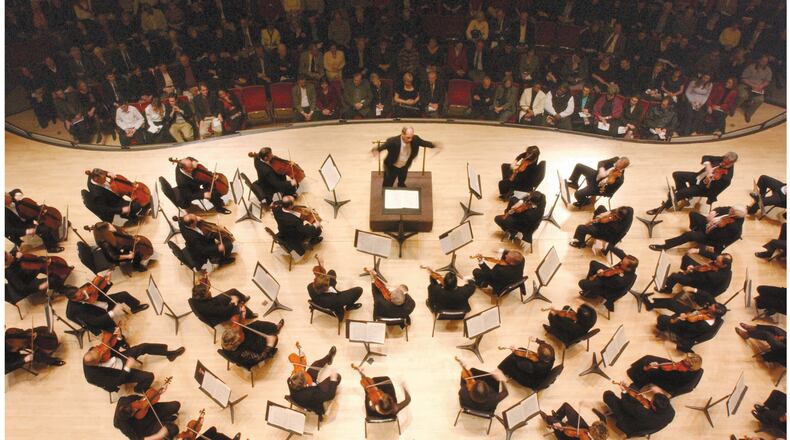As they approach a negotiating session with a federal mediator on Wednesday, Atlanta Symphony Orchestra management and players are closer to a deal than they have been during a two-month musician lockout or in eight months of talks that preceded it.
The question, with a tremendous amount riding on it, is if the two sides are close enough to finally reach accord on a collective bargaining agreement.
If they can, the music will return on Nov. 13 and 15.
If they can’t, expect additional cancellations on top of the eight concerts management called off in late September that would have launched the 70th anniversary season.
There has been little cause for optimism in this extended, ugly dispute that has commanded national and international media attention. But the fact that the two sides are preparing to talk — through U.S. Federal Mediation and Conciliation Service mediator Richard Giacolone — can only be taken as positive.
The negotiating team for the ASO and its parent nonprofit the Woodruff Arts Center (WAC) made a proposal on Oct. 24, to which the musicians countered Oct. 27. Management, which declined comment for this story as part of a news blackout requested by the mediator, didn't outright reject it.
In fact, after further consideration late last week, it believed there was enough of a glimmer of hope to ask Giacolone, whom both sides praise for making progress in the imbroglio, to return to Atlanta and resume mediation. The musicians are primed to receive an updated offer, knowing that differences will remain.
The thorniest issue is the size of the orchestra going forward. The musicians' full-time ranks were trimmed from 95 to 88 and salaries cut by an average of 15 percent in 2012 negotiations that led to a one-month lockout. When the ASO ran up its 12th consecutive year of deficits in fiscal 2014 (finishing $2 million in the red), leadership sought additional trims to the "complement."
In its most recent proposal, management held that the number of full-time musicians for the 2014-15 season should be cut from 88 to the 76 players who remain (after defections, retirements and deaths). It said it would launch a major fund-raising campaign to endow musician chairs with the goal to rebuild the size of the orchestra up to as many as 90 players. That pledge, however, was not promised as part of the proposed four-year contract.
Credit: hpousner
Credit: hpousner
The ASO Players’ Association countered with a proposal of starting with 77 players and increasing the ranks incrementally to a minimum of 88 by the end of the 2017-18 season. The musicians are determined that required positions for the final two years be included in the contract.
"The issue of complement is and has been contractual for decades, just as a fixed complement is for every major American orchestra in their respective contracts," Players' Association president Paul Murphy said in an email to the AJC. "We are asking nothing except to retain our fixed complement of 88 in the contract and ask for best efforts to exceed that number as we try and climb back to our long-standing complement of 95 musicians."
The musicians have said repeatedly throughout negotiations that further cuts to their ranks, requiring extensive use of part-time and fill-in players, would be a major setback to the sound of the 27-time Grammy-winning orchestra.
Richard Deane, who is playing this season for the New York Philharmonic as associate principal horn while officially on leave from the ASO, attempted to explain what's at stake for his Atlanta colleagues. "We are a group, and the group is the thing," Deane said. "We create something where the whole is so much greater than the sum of the parts. Maintaining the group, that's where the magic is, that's where Robert Spano (works his) genius."
Pay is the other issue still to be resolved. Management has not changed its offer of a graduated 4.5 percent raise over the four years. The musicians have moved from proposing a graduated 15 percent raise to one closer to 10 percent.
In a statement released last Friday, the Players’ Association negotiating committee noted, “Every aspect of the Musicians’ proposal provides significant savings for the WAC/ASO, while keeping (the orchestra) on a narrow path toward desperately needed restoration.”
If management believed that the numbers in the players’ last proposal would lead to a balanced budget, Atlantans might already be celebrating the return of the city’s largest arts institution.
Instead, talks resume Wednesday — and continue Thursday if needed — in yet another stab at finding a shared path forward.
“We’re all just so hopeful for consensus,” Deane said. “I couldn’t even begin to hazard a guess about what will happen. Every turn seems like such a surprise.”
About the Author
The Latest
Featured



